MARIANI’S
Virtual
Gourmet
February
16, 2020
NEWSLETTER
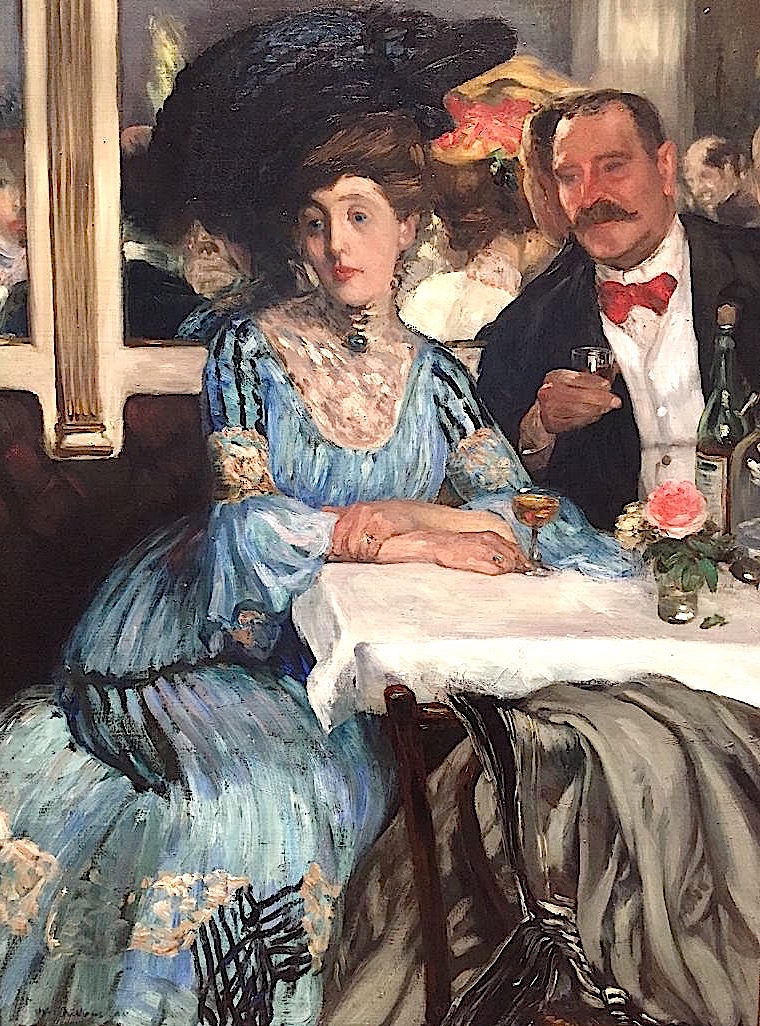
❖❖❖
IN THIS ISSUE
EATING AROUND PAVIA
By John Mariani
NEW YORK CORNER
PORTALE
By John Mariani
NOTES FROM THE WINE CELLAR
THE BAROLOS OF MAURO VEGLIA
By John Mariani
❖❖❖
EATING AROUND PAVIA
By John Mariani
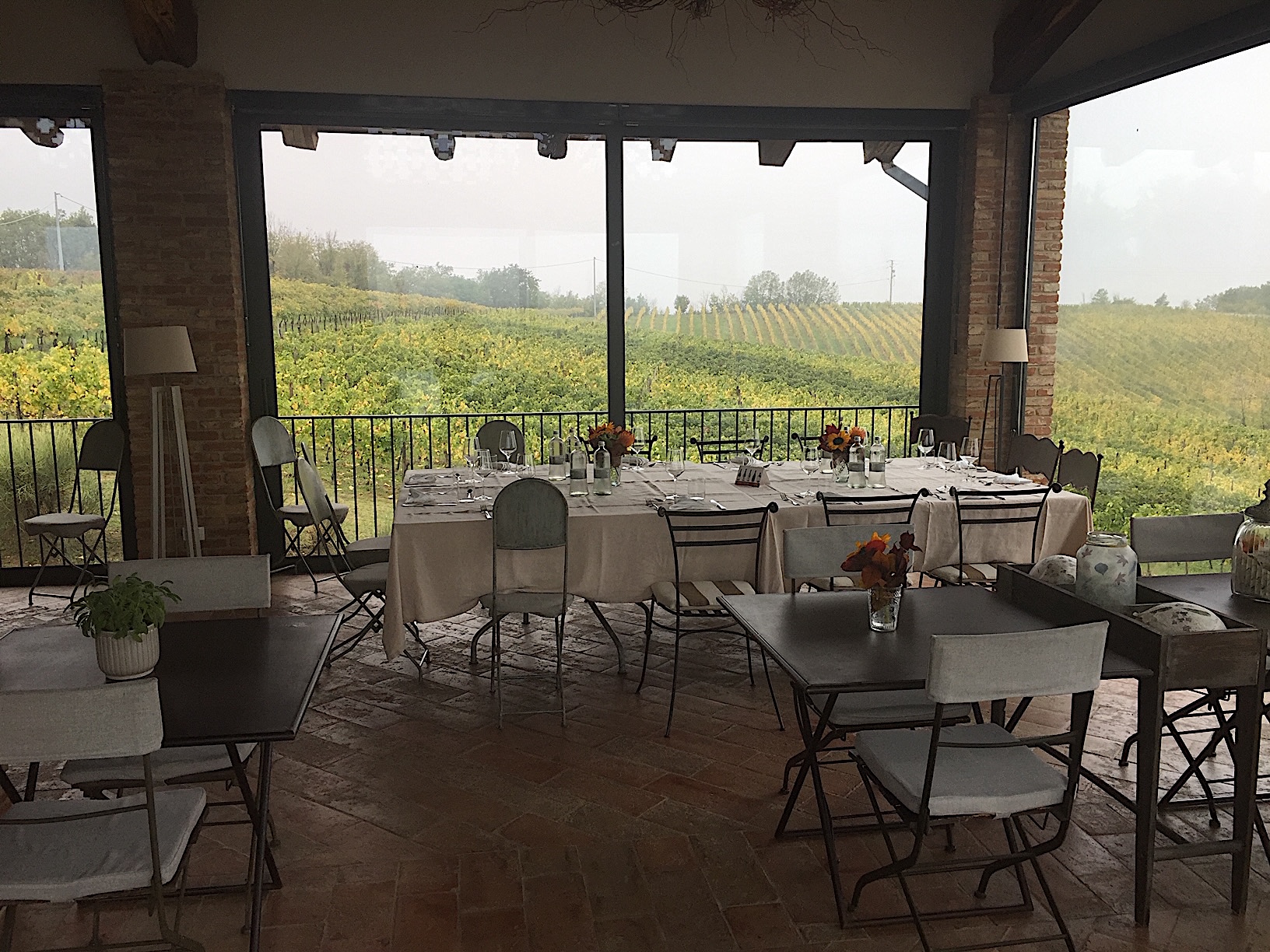
PRIME
ALTURE RESORT, Casteggio
The
region of Pavia and its capital city of the same
name share the abundance of what Lombardy has to
offer, including 13 DOC wine zones. Polenta and
risottos rule over pasta, and dishes like osso buco
and vitello
tonnato deserve their classic status.
Robiola, Gorgonzola, Taleggio, Crescenza and Bel
Paese are all Lombardian cheeses. So you may
assume that
the ristoranti
and trattorie
of Pavia offer a wide range of gastronomic
experiences. Here are a number of every stripe.
(Remember, tax and service are
included in all menu prices.)
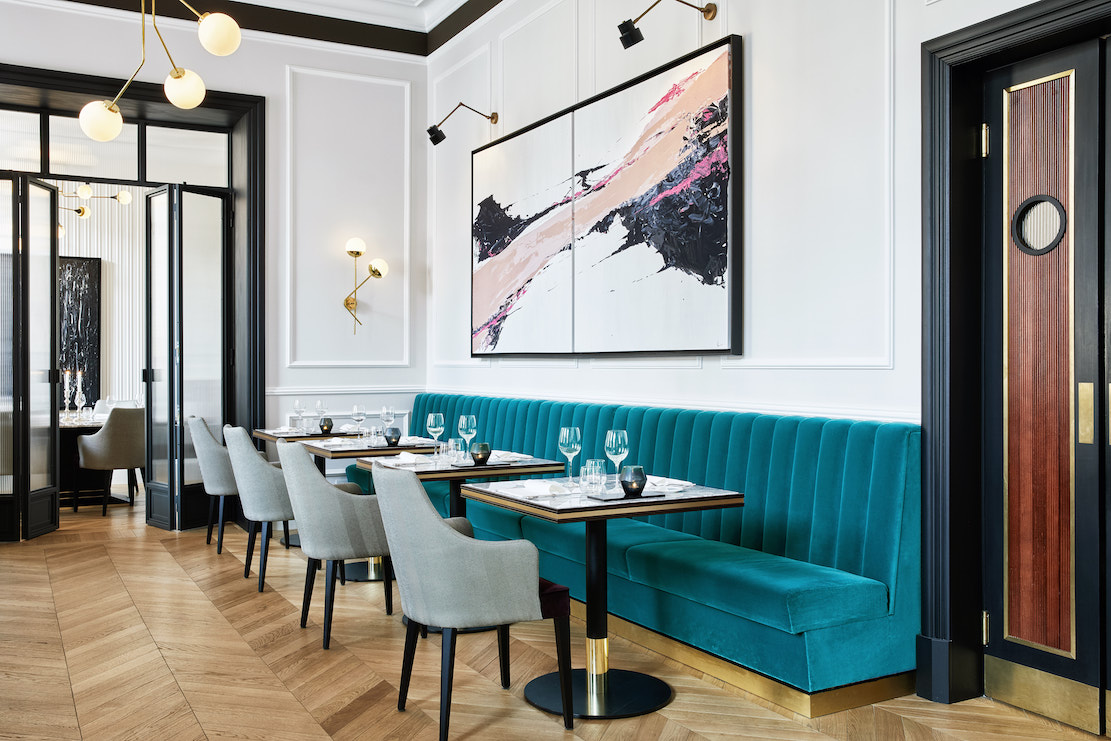 RISTORANTE
LINO
RISTORANTE
LINO
Piazza del Lino, 15
Pavia
382 180 3920
The
new Lino is not only one of the newest and most
modern ristoranti
in Pavia but, to my mind, the best and
certainly the most sophisticated, drawing
largely on the cuisine and ingredients of the Po
Valley.
Located in Piazza del Lino,
within a municipal garden area, Lino’s windows
throw lovely golden light onto the square. Once
through the front door you find yourself in a chic
bar and lounge whose size, neither small nor
large, is perfect for a pre-dinner cocktail. The
décor of the dining room, done in strong and pale
colors, with its tall windows, is a reflection of
the influence of Milan on chic contemporary
design. Manager and maître d’ Fabrizio Ciccarello
is the impeccably dressed fellow with the
impeccable Lombardian manners.
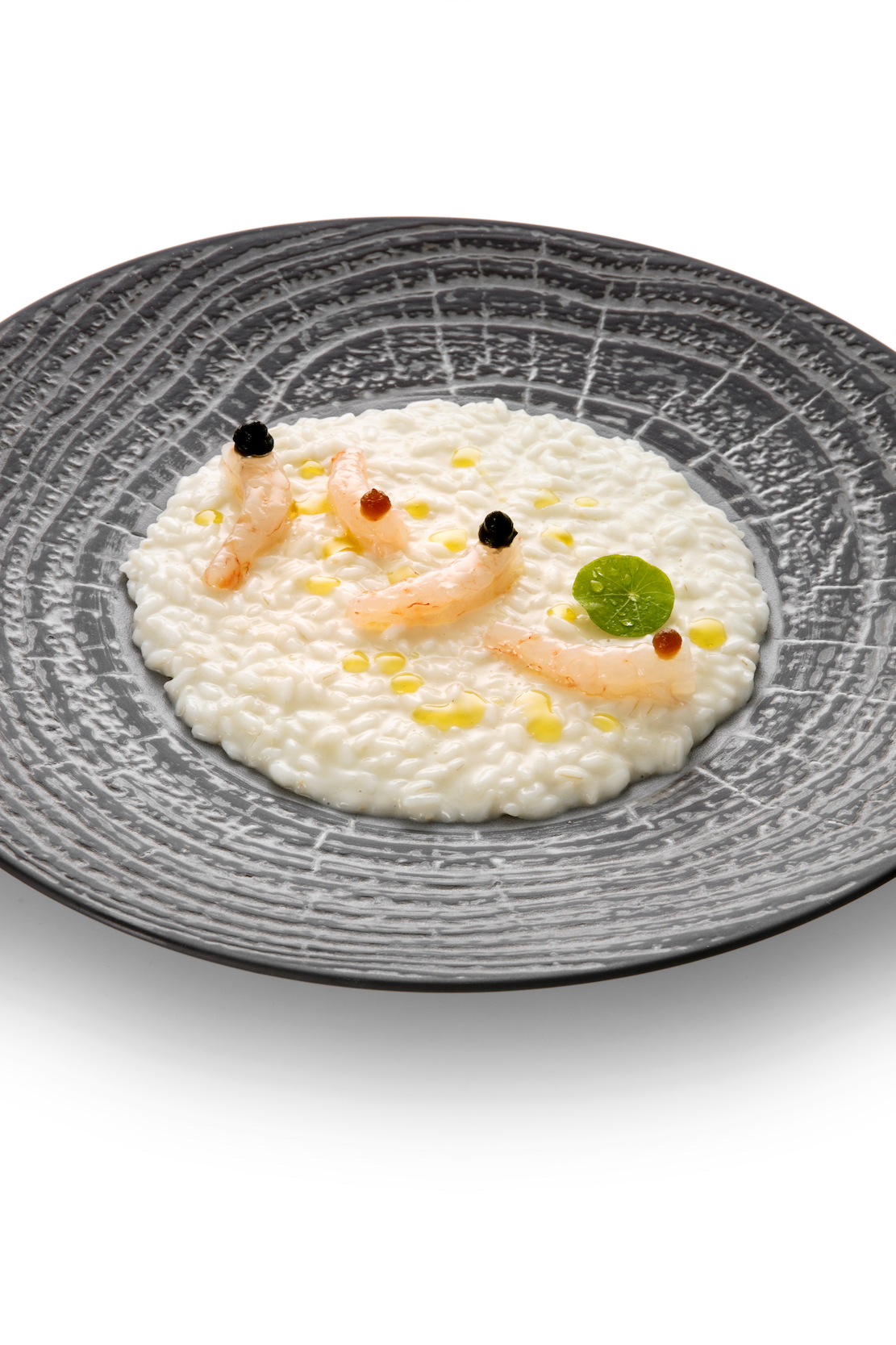 Chef
Federico Sgorbini, with the consultancy of the
highly regarded Andrea Ribaldone, offers an
exceptionally well-priced four-course menu at €55
(also à la carte);
my meal began with small arancini
rice balls wrapped in cuttlefish skin dotted with
barbecue sauce. “Grissino
bollito” (right)
which means “boiled breadsticks,” is actually
spaghetti colored and scented with saffron and
served with a wild boar sauce (€16). The
most marvelous dish was veal cheeks stewed in red
Bonarda wine with tamarind that were exquisitely
tender and flavorful (€24).
Chef
Federico Sgorbini, with the consultancy of the
highly regarded Andrea Ribaldone, offers an
exceptionally well-priced four-course menu at €55
(also à la carte);
my meal began with small arancini
rice balls wrapped in cuttlefish skin dotted with
barbecue sauce. “Grissino
bollito” (right)
which means “boiled breadsticks,” is actually
spaghetti colored and scented with saffron and
served with a wild boar sauce (€16). The
most marvelous dish was veal cheeks stewed in red
Bonarda wine with tamarind that were exquisitely
tender and flavorful (€24).
For dessert zuppa di
voghera
was a chocolate-coffee gelato with cardamom
gelée and hazelnuts
(€10).
The wine list, as you might
imagine in a restaurant of this caliber, is
outstanding, with all the finest Lombardian
labels.
BARDELLI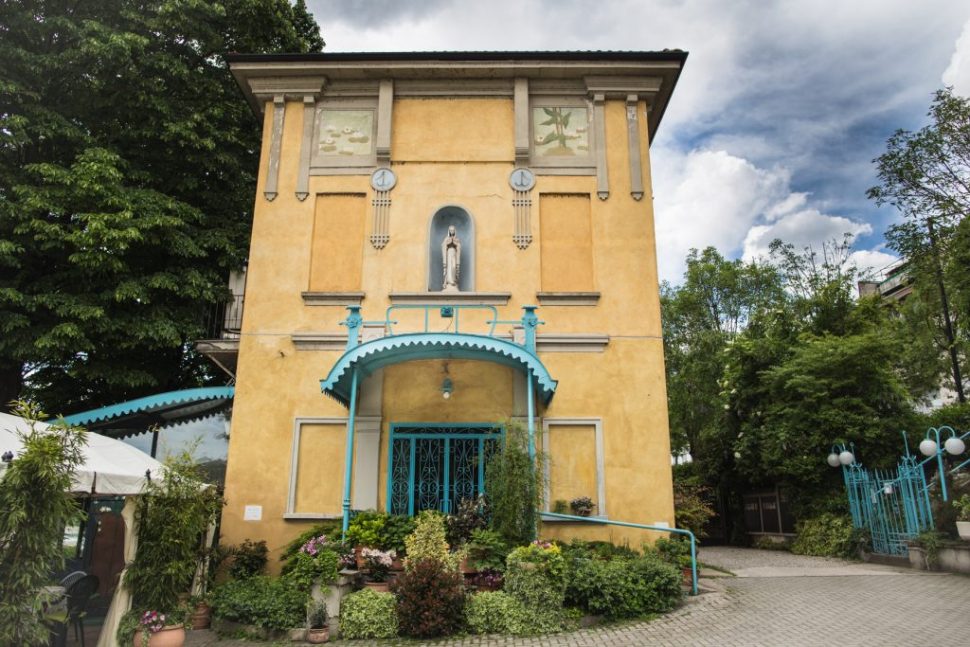
Lungo Ticino Visconti 2
Pavia
382 27441
Bardelli
is an elegant but not at all stuffy ristorante near
the covered bridge in the heart of Pavia, restored
in 1960 from an old boat building structure.
The lovely 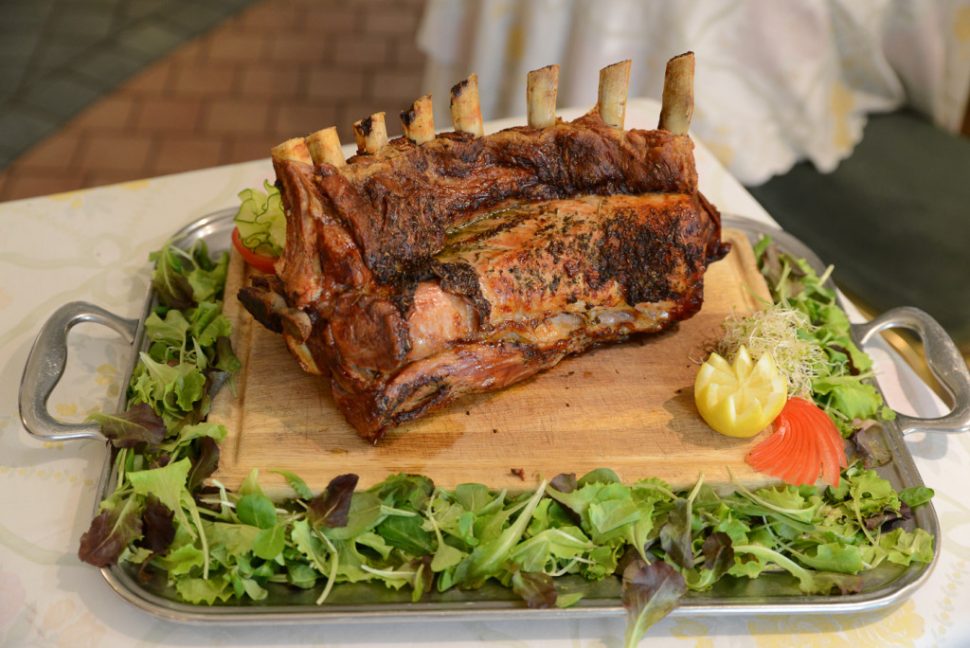 glass-enclosed
dining room overlooks the river and has a ceiling
of billowing Fortuny fabrics. There is an à la
carte menu (with antipasti €16-€20; pastas
€13-€24; main courses €20-€24) and a menu
degustazione at a remarkable €40 per person.
glass-enclosed
dining room overlooks the river and has a ceiling
of billowing Fortuny fabrics. There is an à la
carte menu (with antipasti €16-€20; pastas
€13-€24; main courses €20-€24) and a menu
degustazione at a remarkable €40 per person.
My menu the night I visited
began with a polenta torta
rich with aged
Grana Padana cheese and a creamy center. Risotto
with butter and Parmigiano, artichokes and
Taleggio was simply and sumptuously good, followed
by delicately thin tortelli with braised beef and
aromatic sage.
Roast veal (left) was superb, and even
though it seemed unseasoned it was suffused with
its own roasting juices. A sorbetto smoothie
came before dessert, which was an array of petit
fours.
RISTORANTE PEO
Hotel Moderno
Viale Vittorio Emanuele II, 29
Pavia
382-175-1539
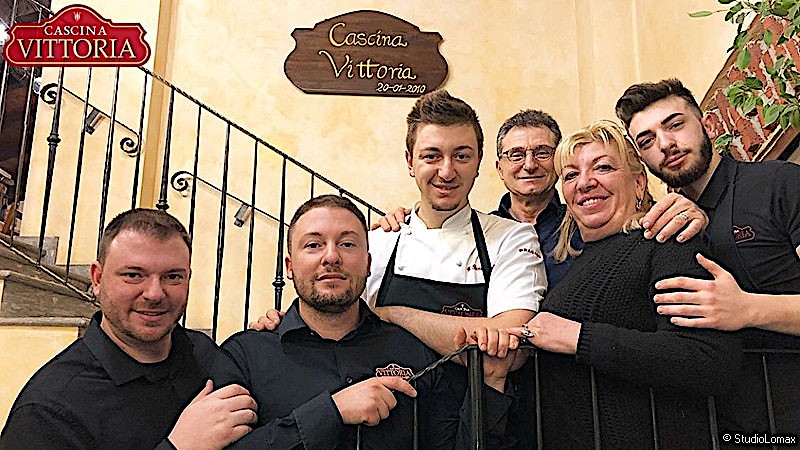 CASCINA VITTORIO
CASCINA VITTORIO
Via Roma, 26
Rognano
382-185-5538
Cascina
Vittorio is set on two floors of a 19th century
country home, now a destination for gourmands who
drive in from nearby Pavia and Milan. Chef
Giovanni Ricciardelli, together with his wife and
family, works within traditions refined by his own
youthful sensibility. His is a rustic cooking full
of big flavors, 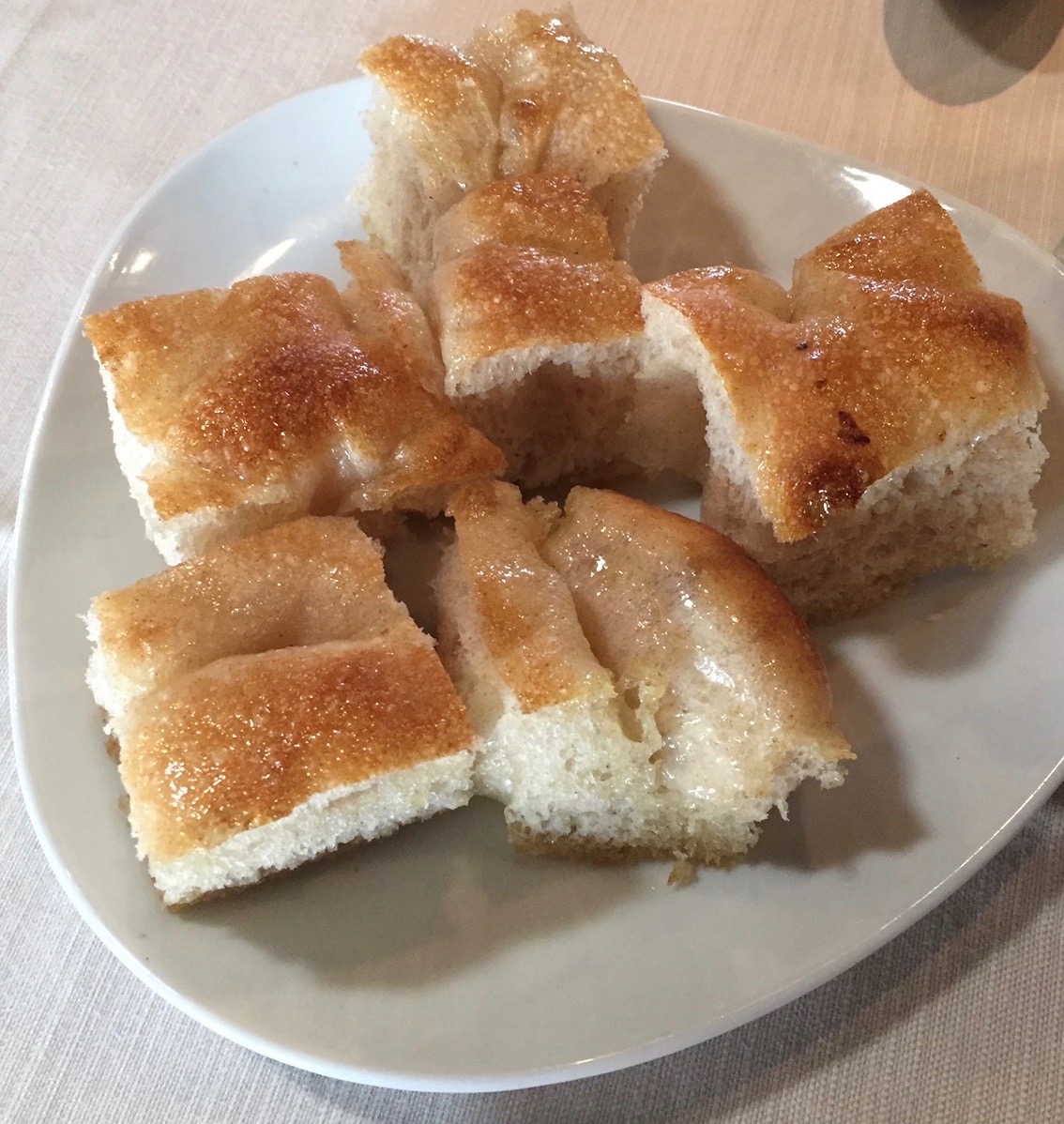 even
including the best, most moist, olive-glossed
focaccia I’ve ever had (right).
even
including the best, most moist, olive-glossed
focaccia I’ve ever had (right).
My meal, fixed priced at €60,
included one of his signature items—he claims to
sell 500 a week—layers and layers of eggplant millefoglie enriched
with Parmigiano. This was followed with risotto mantecato
(below)
with local squash from Bertagnina di Dorno,
beautifully composed with a sauce of Gorgonzola
and Calabrian licorice flavorings.
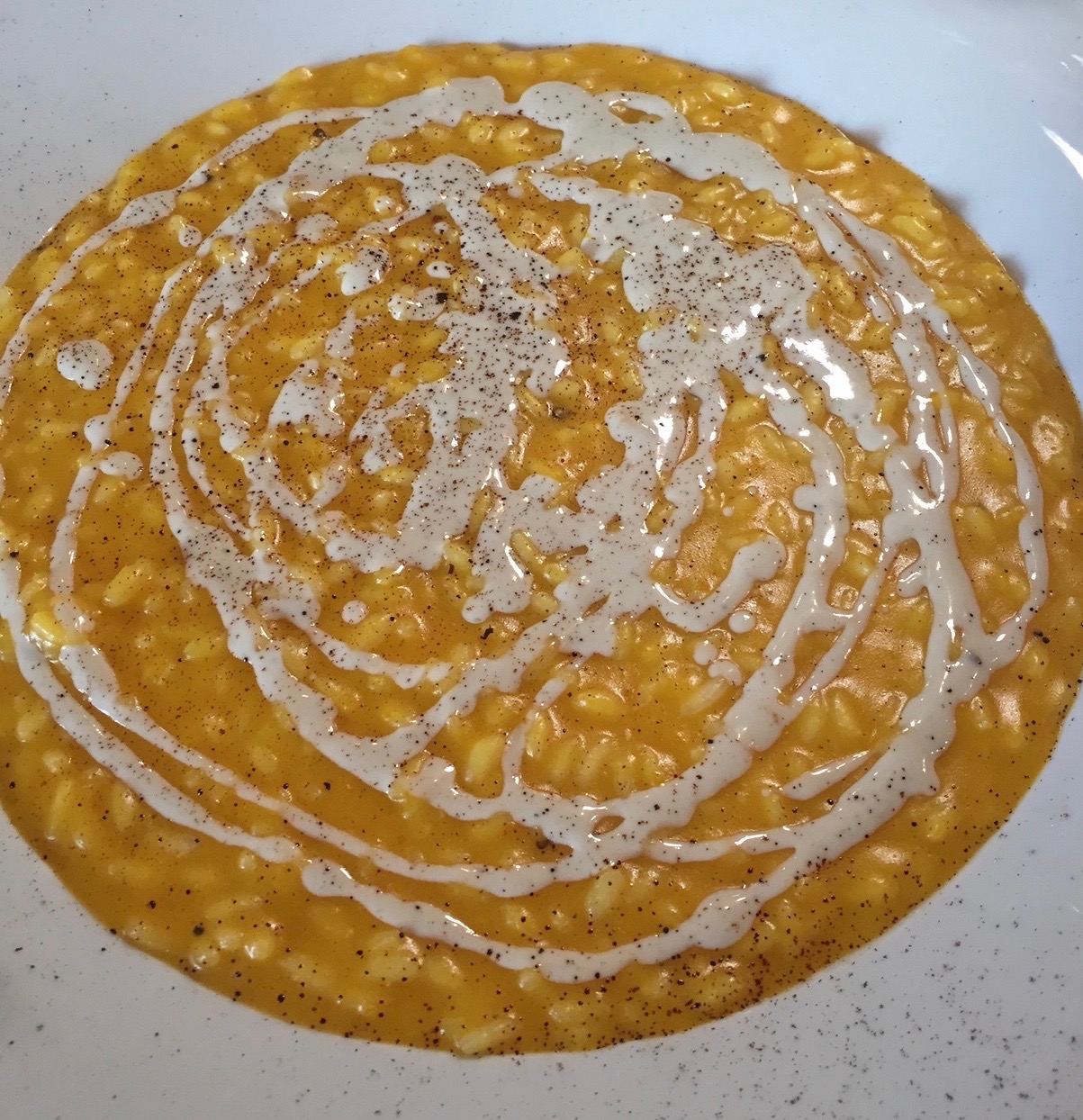 The main
course was a very traditional brasato
of local beef cooked for hours in Bonarda and
Barbera wines, served with crisp potatoes and
herbs. All you need is a fork to eat the
super-softened meat.
The main
course was a very traditional brasato
of local beef cooked for hours in Bonarda and
Barbera wines, served with crisp potatoes and
herbs. All you need is a fork to eat the
super-softened meat.
Dessert was a soft, light golden
panettone
cake that is baked and sold downstairs, dotted
with candied fruit and served with fresh cream.
You eat it with your fingers and a cup of
espresso.
PRIME ALTURE RESORT
Str. Madonna, 109
Casteggio
383 83214
Constructed
by a fellow named Roberto Lechiancole, who made a
fortune crafting helicopter blades, this small
eco-tourism six-room resort within the vineyards
has a splendid trattoria overlooking the Pavian
landscape. The wine cellar and tasting room, whose
tables are made from corks, is a charming spot to
nibble on some bread and salame
while sampling the nine wines made here.
There is a stress on seasonal
vegetables as well as grilled items from local
cows, pigs and chickens, and game in the fall and
winter, which goes into the making of the salume,
the mini-meatballs
and cheeses. In the trattoria I enjoyed a
deceptively simple risotto with Molana del Brallo
cheese and aromatic herbs mixed with a crumble of
cotechino
pork sausage (right)
and a reduction of Pinot Nero wine.
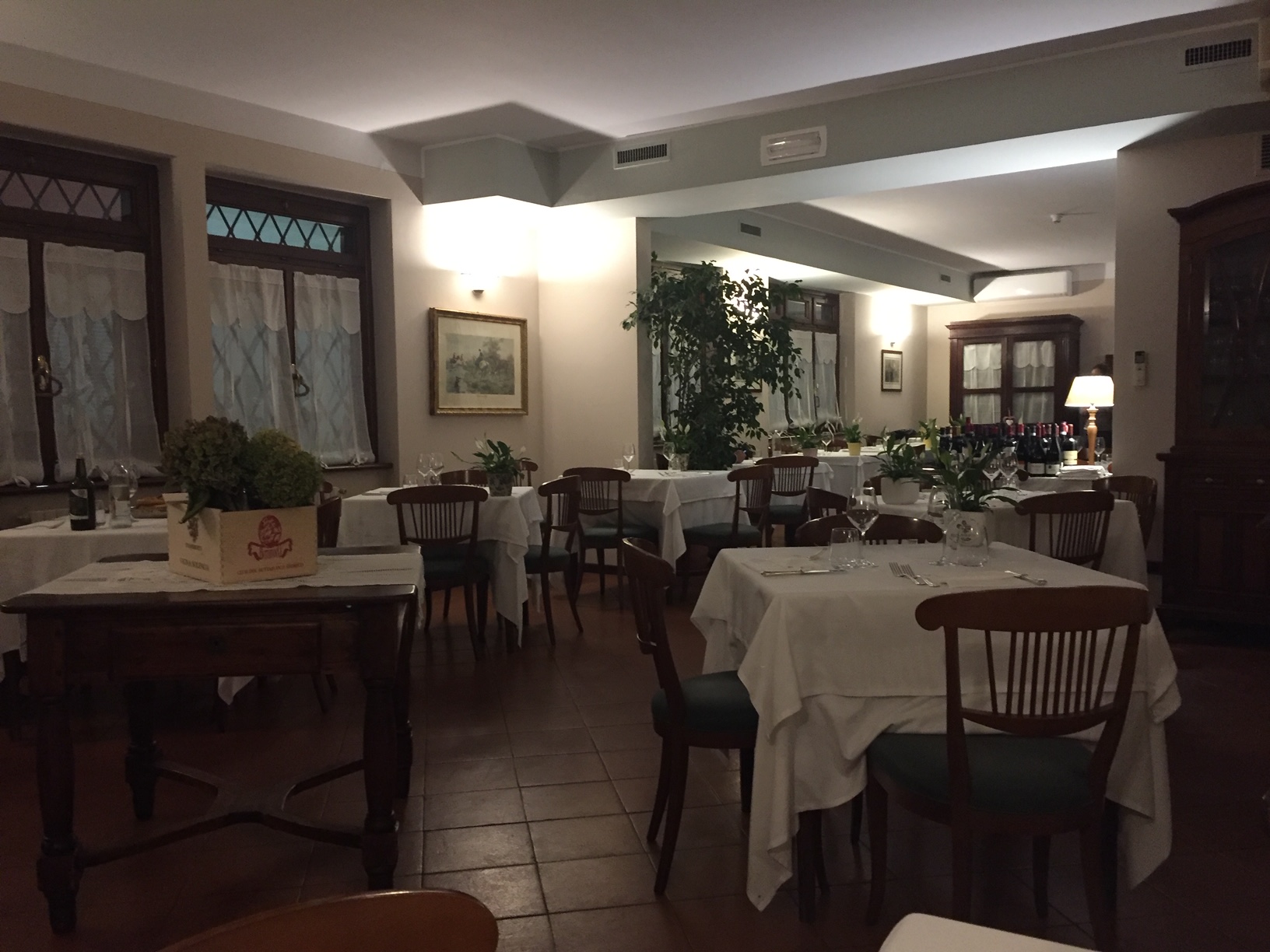 ALBERGO SELVATICO
ALBERGO SELVATICO
Via S. Pellico, 19
Rivanazzano Terme
383 944720
Albergo
Selvatico established its reputation with locals
and visitors as a hotel in 1912, and today
fourth-generation owner Piera Spalla Selvatico and
her daughters Michela and Francesca and husband
Sergio Dagliua
still run everything with enormous courtesy and
care, in both the kitchen and big low-lighted,
L-shaped dining room.
A tasting menu began with a
glass of sparkling wine from La Versa and a
selection of local salame
from Varzi and peppers stuffed with anchovies and
coppa
pork sausage. Then came a torta of
squash shaped like a priest’s hat with a fonduta of
Taleggio cheese. Tagliatelle
made from chestnut flour came with autumn’s best funghi
porcini, while agnolotti (right) was
graced with a stewed meat ragù.
There is also a risotto made with green wild hops
cooked with lard and butter, and another with
sweet red peppers.
The main course was a
carpaccio of beef darzese (from
an “old race”) of cattle, and to finish, an apple
crumble with warm, whipped custard zabaglione.
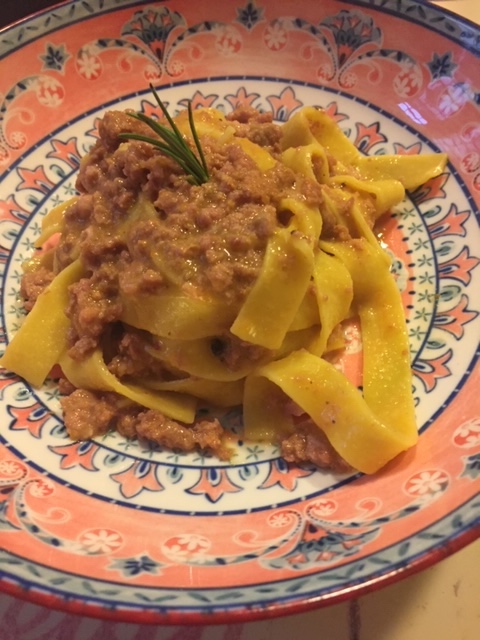 L’OCA CIUCA
L’OCA CIUCA
Via XX Settembre
Vigevano
381-348091
Anywhere
L’Oca Ciuca were located, it would be
extraordinary in the true sense of the word, in
that it specializes in dishes made with
goose—goose salame,
goose sausage, goose pastas, goose risotto, goose
stew, roast goose! That it is located on a
charming street off the main piazza of the Pavian
city of Vigevano makes it all the more requisite
for anyone visiting the area to eat there. In two
rooms with 20 tables, Fulvia, Stefano, Rossana and
Rinaldo cook for you and serve up big portions of
very lusty Lombardian fare.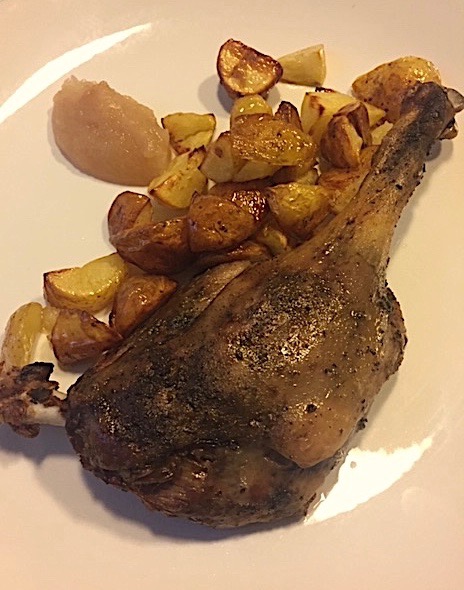
Over a long lunch with wines
from a 150-label list, I began with a flan of
pumpkin with a silky besciamella
enriched with Taleggio (€8)—a rare non-goose dish.
Then came a selection of well-fatted goose-based
charcuterie (€15); Carnaroli risotto with big
borlotti beans and goose sausage (€14); freshly
made egg tagliatelle
(above)
with a meaty goose ragù (€13);
and a leg of crisp-skinned goose (€20) cooked for
twelve hours (right).
For dessert there’s a fruit crostata
(€6) and a local favorite, sbrisolona
alla mandorla (€6), a cornmeal and almond
cake with warm whipped zabaglione.
By John Mariani
Photos: Pat Dunford
126 West 18th Street (near Avenue of the Americas)
917-781-0255
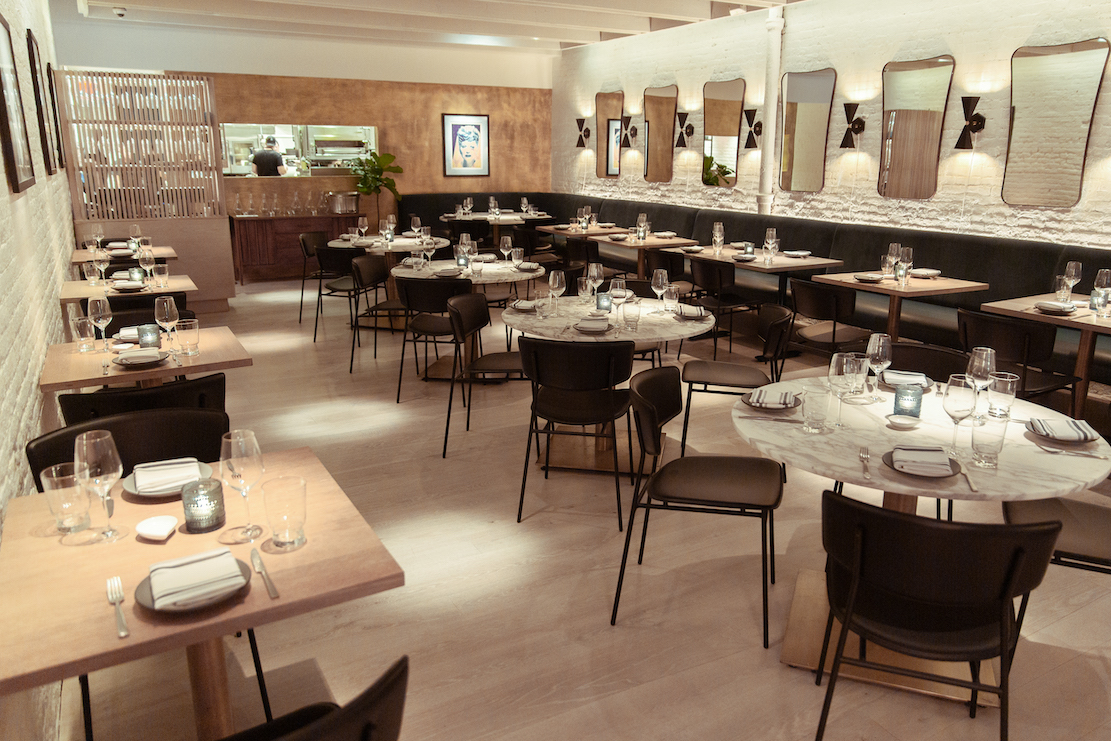
Years
ago I was pretty sure that Alfred Portale
would stay in his kitchen at Gotham Bar
& Grill forever—he was there for
thirty-four years—so it was to my surprise
that he left Gotham to move a few blocks
away to open his own namesake restaurant.
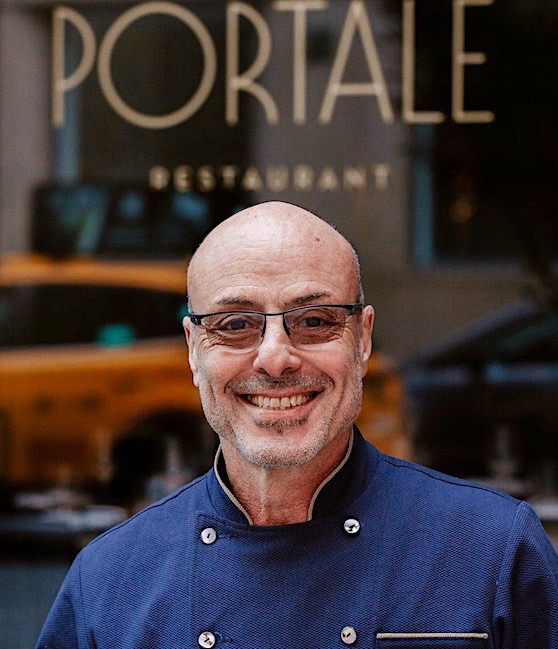 Portale
was among that group of innovative chefs of
the 1980s who had come up the old-fashioned
way, putting in his time with old masters,
like Michel Guérard, Jean Troisgros and
Jacques Maximin, absorbing every aspect of his
craft. When he took over Gotham, which
Portale
was among that group of innovative chefs of
the 1980s who had come up the old-fashioned
way, putting in his time with old masters,
like Michel Guérard, Jean Troisgros and
Jacques Maximin, absorbing every aspect of his
craft. When he took over Gotham, which 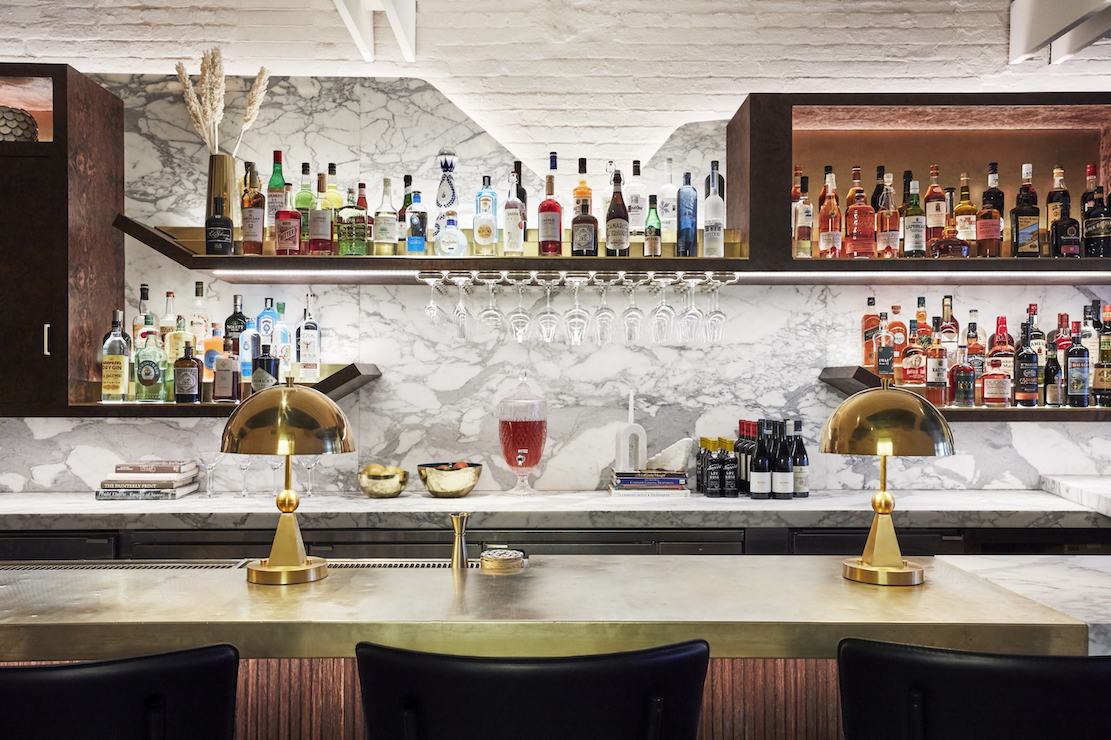 had
been a disaster since the day it opened, he
brought his entire arsenal of talents to
create his own distinctive style of
French-American cuisine, becoming famous for
his layered towers of food on the plate that
everyone copied.
had
been a disaster since the day it opened, he
brought his entire arsenal of talents to
create his own distinctive style of
French-American cuisine, becoming famous for
his layered towers of food on the plate that
everyone copied.
Increasingly at Gotham (and
everywhere else) Italian accents entered the
menu, so it is no surprise that his new
restaurant was going to be modern cucina
Italiana from antipasti to dolci,
with a thoroughly Italian wine list (overseen
by Steven Washuta).
Portale is composed of two
dining rooms, one with a handsome bar, the
other larger, extending to the glassed-in
kitchen. There is a good deal of raw materials
like reclaimed timber and bleached white oak,
as well as white brick walls, burled maple and
gray and white marble tabletops. This
makes for a lot of hard surfaces and a good
deal of noise, not in the least helped by boom
box sounds in the mix. The lighting at 7 p.m.
is enchanting—you can see everyone coming and
going and read the menu with ease—so I can’t
imagine why they lower the lights after 8
o’clock, which makes difficult both reading
the menu and enjoying the bright colors of the
well-crafted dishes.
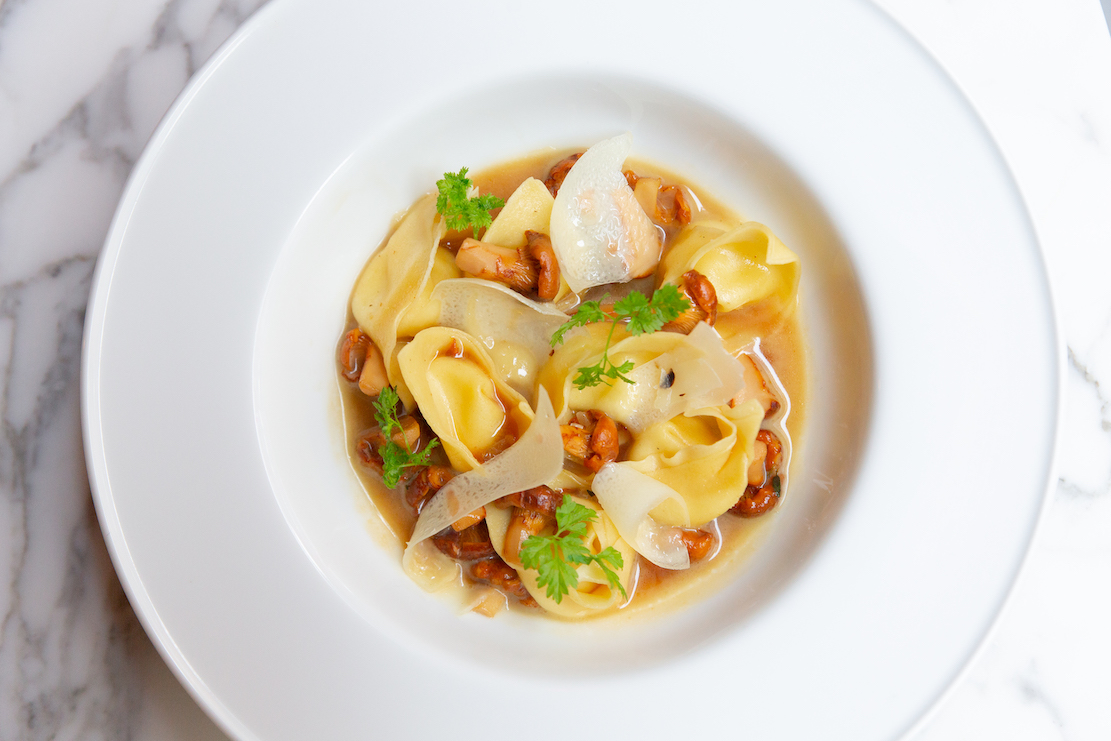 A lack of any dress
guidelines—“codes” are almost non-existent
anywhere—means that any gentleman in a jacket
looks elegant at Portale and the rest don’t.
On one visit there was a very strange, very
large man in a very bulky forest camouflage
suit and matching lumpy hat who looked either
like he was on the hunt for Big Foot or was
Big Foot himself in camouflage.
A lack of any dress
guidelines—“codes” are almost non-existent
anywhere—means that any gentleman in a jacket
looks elegant at Portale and the rest don’t.
On one visit there was a very strange, very
large man in a very bulky forest camouflage
suit and matching lumpy hat who looked either
like he was on the hunt for Big Foot or was
Big Foot himself in camouflage.
The menu is of an ideal
size, neither too concise nor maddeningly
large. With chefs de cuisine Jacinto
Guadarrama and Adam Longworth, Portale shows
the kind of finesse his cooking has always
had, not just in the glossy pastas but in the
crisp-skinned main courses.
There
are some “Small Snacks” at the top of the
menu, including some deliciously chewy pagnotta
integrale ($5), a loaf of warm whole
wheat bread. Hamachi crudo
was a fine and pretty dish, but one now
ubiquitous around town. On two tries I found
the fritto
misto ($21) of calamari, shrimp and cod
with lemon aïoli tasted more like its
tempura-like batter than what was inside.
Every pasta I tried was
outstanding, all with the proper chew and the
pasta itself the star on the plate. Cavatelli
made with ricotta ($19) came in a fiery arrabiata
sauce and a little coriander pesto;
Fat but delicate cappellacci
($24) were stuffed with goat’s cheese and
wild mushrooms, while ruffled campanelle
came with a deeply flavorful duck ragù
and perfectly cooked broccoli di rape;
snail-shaped lumache
were heartier still, rich with short ribs meat
and a white Bolognese sauce, black truffles
and parmigiano ($28). The risotto with
hedgehog mushrooms, spinach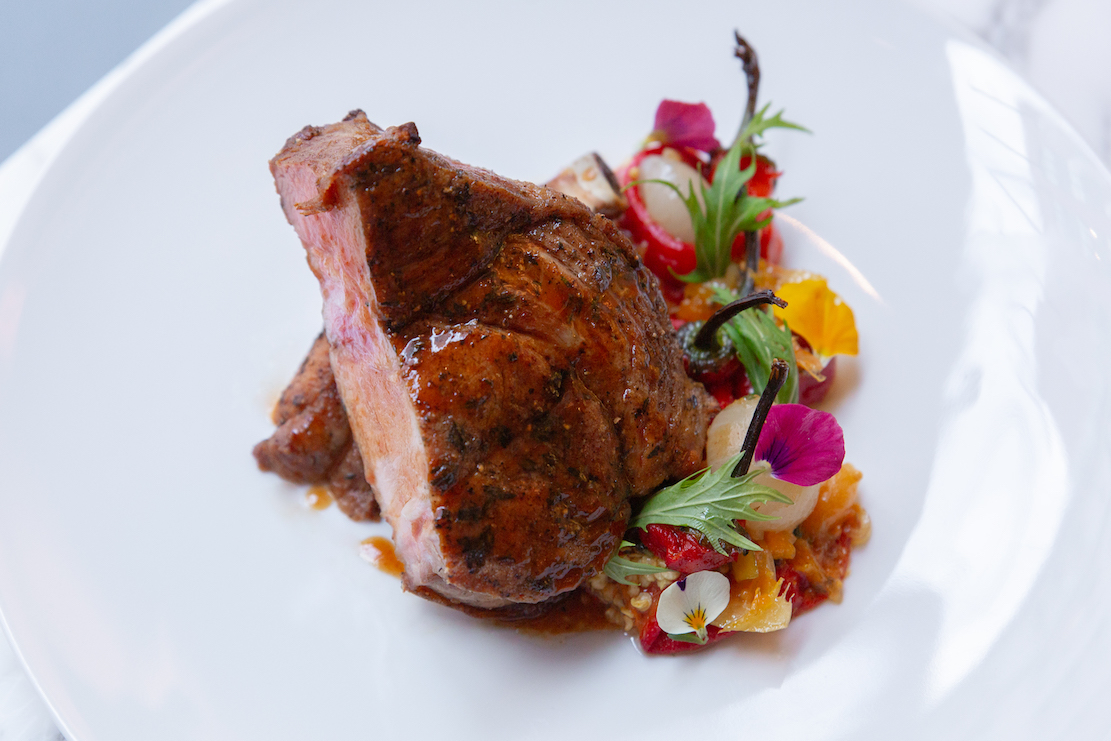 and
luscious fontina ($26) gets all the texture
and flavors coalesced in harmony.
and
luscious fontina ($26) gets all the texture
and flavors coalesced in harmony.
I should add that the pasta
dishes are full main course portions, and
there are plenty of lower-end Italian
trattorias charging the same prices and too
many high-end restaurants charging a great
deal more. Pastas at Ai Fiori are all $37.
Carbone won’t even list their prices on the
website for fear people will faint. Indeed,
prices across Portale’s menu are lower than
competitors’ like Felidia and Del Posto.
It is almost expected that
Italian kitchens’ main courses—secondi—will
be
simpler and less savory than the antipasti and
primi,
but Portale’s secondi
are all a match for what preceded them,
starting with an impeccably cooked, plump
branzino with delicate squash, red Swiss chard
and sundried tomatoes ($33). 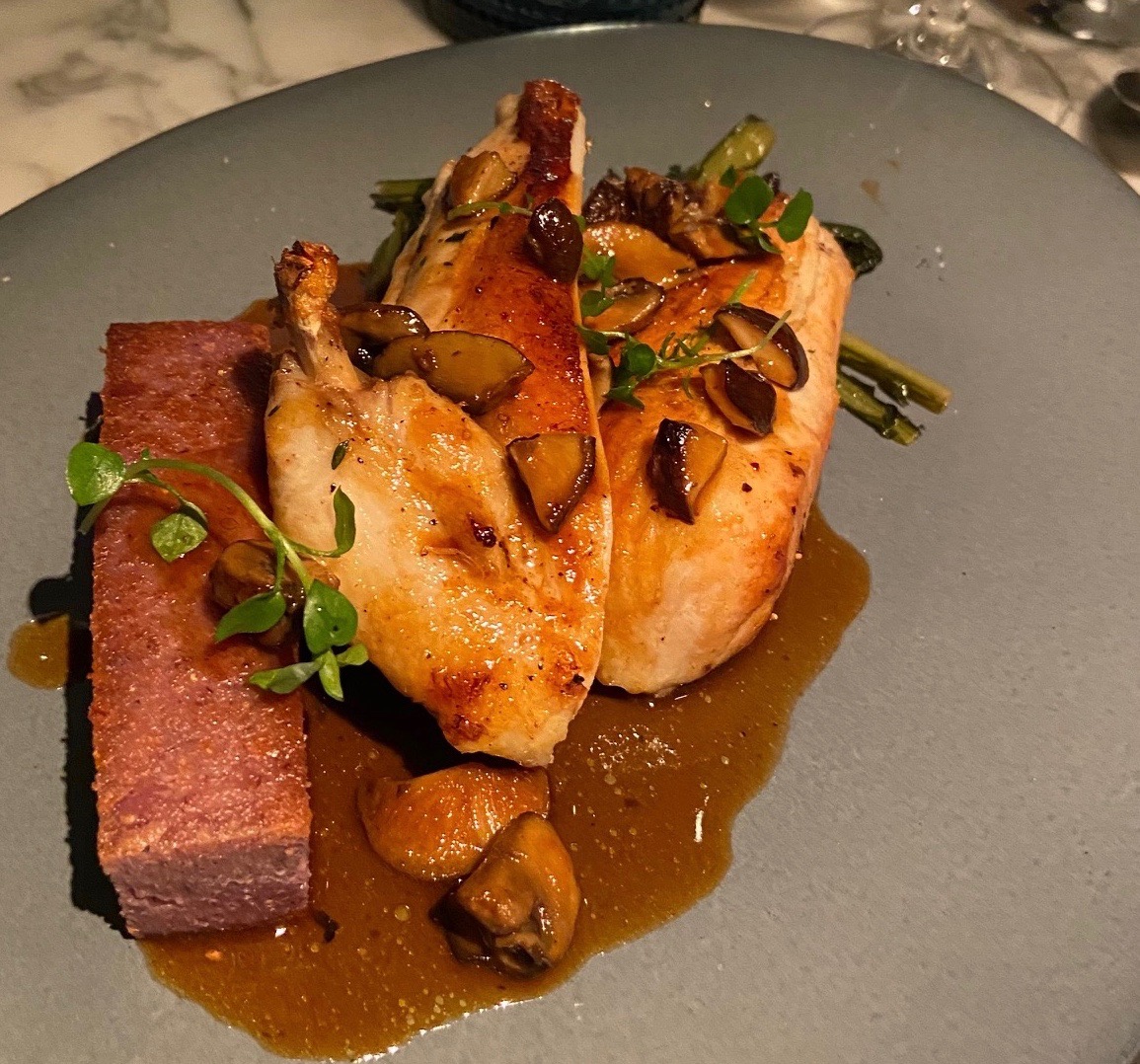 Duck breast’s skin
is as crisp as at a fine Chinese restaurant,
with pink, juicy meat within, served with sun
chokes, radicchio and chili honey that makes
it closer still to Peking duck ($38). Roast
pork, rarely seen on New York Italian tables,
is very good, nicely fatted, with roasted
peppers and a piquant orange mostarda
($36). And long ago Portale mastered his
roast chicken technique, resulting in a
glistening, brined and browned bird with
woodsy mushrooms, tangy dandelion greens and
blue corn polenta ($29). And if you really,
really crave beef, you’ll find the bistecca
dry-aged sirloin, at a very reasonable $44,
much to your taste, with Brussels sprouts and
crisp, crushed fingerling potatoes dusted with
Parmigiano.
Duck breast’s skin
is as crisp as at a fine Chinese restaurant,
with pink, juicy meat within, served with sun
chokes, radicchio and chili honey that makes
it closer still to Peking duck ($38). Roast
pork, rarely seen on New York Italian tables,
is very good, nicely fatted, with roasted
peppers and a piquant orange mostarda
($36). And long ago Portale mastered his
roast chicken technique, resulting in a
glistening, brined and browned bird with
woodsy mushrooms, tangy dandelion greens and
blue corn polenta ($29). And if you really,
really crave beef, you’ll find the bistecca
dry-aged sirloin, at a very reasonable $44,
much to your taste, with Brussels sprouts and
crisp, crushed fingerling potatoes dusted with
Parmigiano.
Desserts by Kaity Mitchell
are safely traditional but delectable enough
and good for sharing, especially the milk
chocolate tiramisù dome with espresso gelato
($14), and the pear tart with maple
mascarpone, poached pears and maple gelato
($14). A selection of three cheeses is $17.
Portale’s wine list
admirably offers plenty of wines by the glass
under $20, and there is a remarkable number of
amaro
digestivi, though I suspect including
the wicked-tasting Fernet Branca at $14 is a
joke.
I expected
nothing less from Alfred Portale that his new
restaurant has the same elevated refinement
I’d always enjoyed when he cooked at Gotham
(which I shall be writing about next week),
but he seems even more in his element. Call it
a comfort zone, and his heart is clearly in
every detail. Portale is, along with Felice
56, one of the most impressive ristoranti
to open in New York in a long time.
Open for lunch Wed.-Fri.; dinner nightly; brunch Sat. & Sun.
❖❖❖
THE BAROLOS OF MAURO VEGLIA
By John Mariani
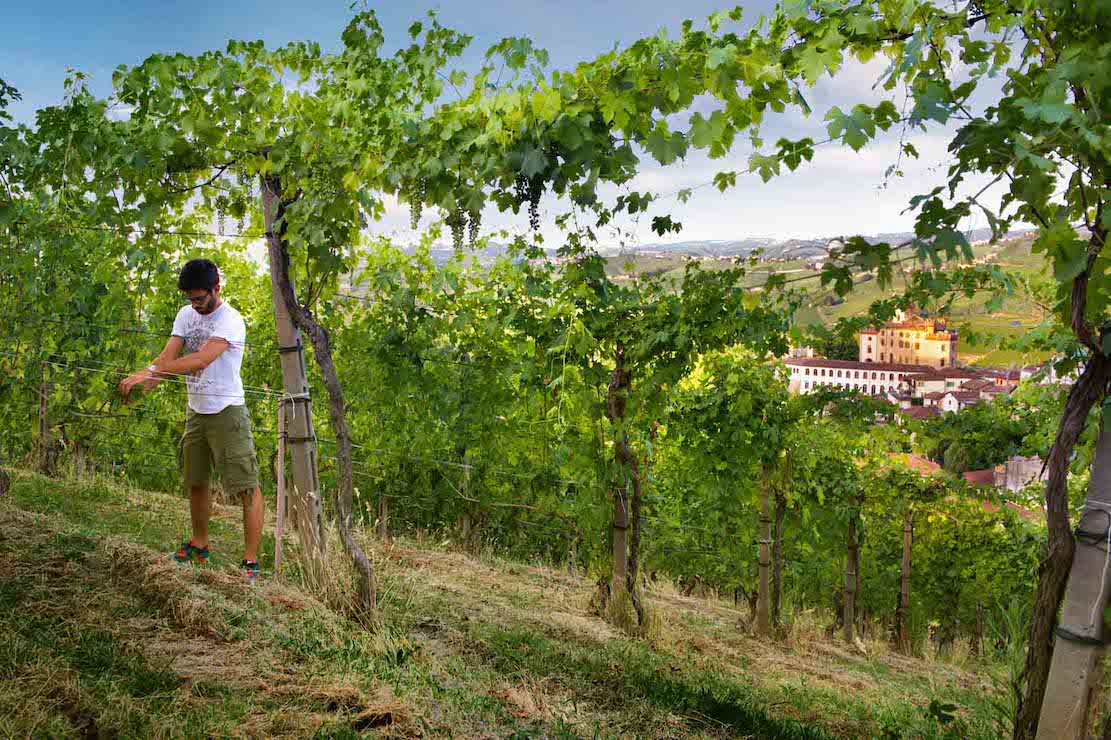
Given the current popularity of
Barolos—with some top labels selling for up to
$400 a bottle—it’s hard to believe that less
than a half century ago the wine was barely sold
outside of Piedmont, where it is made.
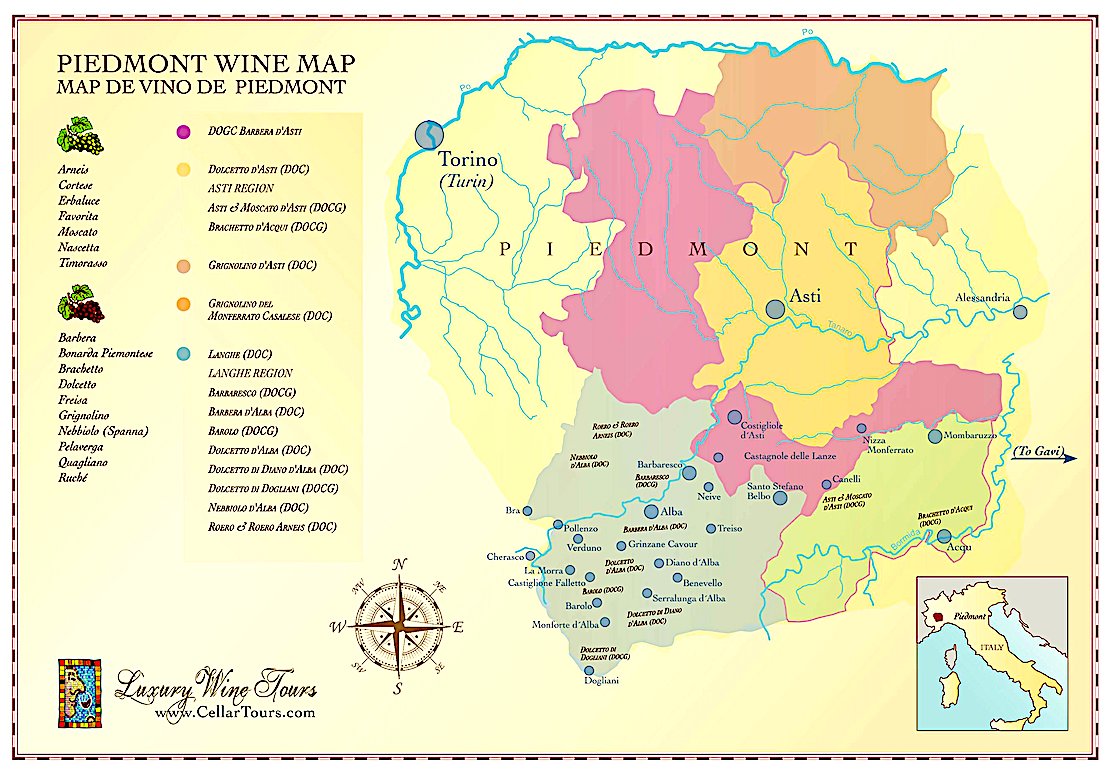 “Piedmont was once very
poor,” says Alessandro Veglio of Mauro Veglio
winery in La Morra. “The market value of Barolo
back then was zero.” Indeed, Barolos were often
given away free with the sale of a demijohn of
Dolcetto, a lesser wine drunk in large
quantities locally.
“Piedmont was once very
poor,” says Alessandro Veglio of Mauro Veglio
winery in La Morra. “The market value of Barolo
back then was zero.” Indeed, Barolos were often
given away free with the sale of a demijohn of
Dolcetto, a lesser wine drunk in large
quantities locally.
Today, however, Piedmont is one
of the top export regions, with 1 billion Euros in
sales. Although
seventh in terms of quantity produced among
Italy’s 20 wine regions, it is second only to
Veneto, which exports vast quantities of Prosecco,
worth 2.2 billion Euros. A large part of Piedmont’s
surge is due to Barolo, where a top vineyard may
sell for 2 million Euros, compared with ten years
ago, when the price was 1 million.
The Veglio family in Piedmont
knows well the history of the area’s viniculture,
having worked the land since the beginning of the
last century,
cultivating, raising livestock and
“inventing new ways of getting by every day.”
Angelo Veglio, born in 1928, sought to escape the
life of a sharecropper to own a vineyard, which he
could not do until the1960s in the township of La
Morra. In 1979 the family acquired a shabby
farmhouse called Cascina Nuova and some of its
property with about five hectares of vineyards
that contained cru appellations 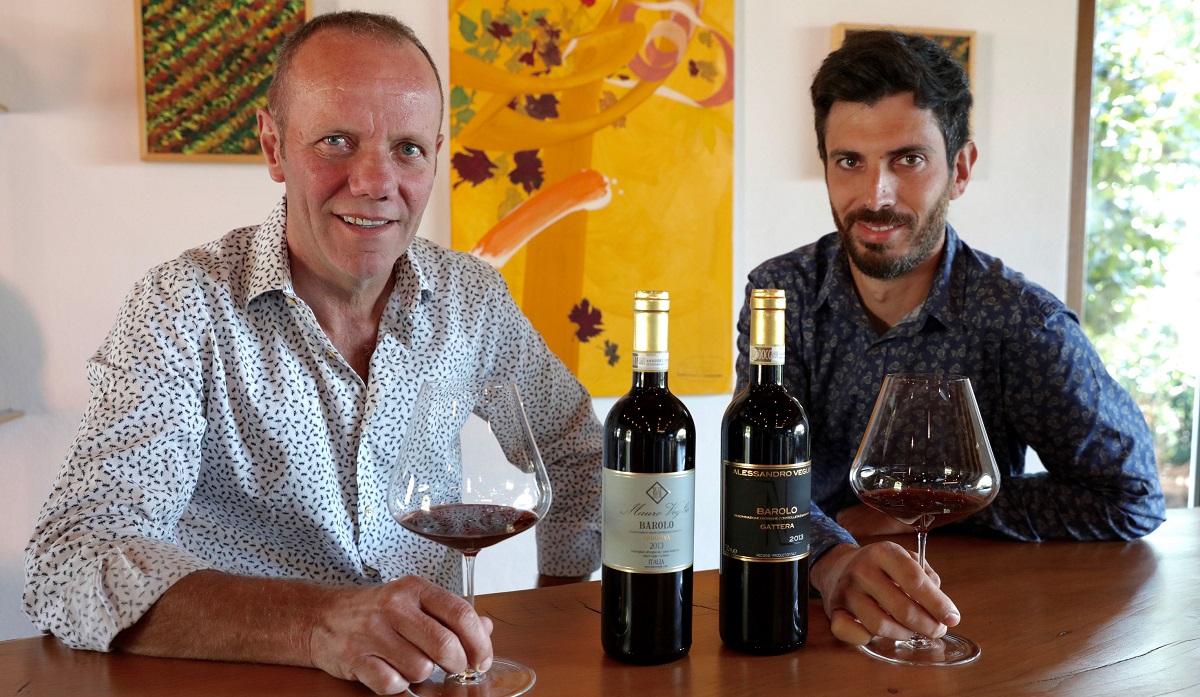 of
Arborina and Rocche dell’Annunziata.
of
Arborina and Rocche dell’Annunziata.
Angelo’s son Mauro (of three)
believed in his father’s dream that Barolo could
be a great wine and make a profit, taking over the
management of the winery in 1986. A decade later
the vineyards of Monforte d’Alba were
added to their property in La Morra, just as
Barolo began its rise in reputation in the
international wine market. Veglio invested in
modern technology, eschewing age-old methods that
had given Barolo a reputation as an ill-made,
heavy, dark red wine. In 1992 Veglio had its first
harvest and vinification in the new winery, built
next to the foundations of the Cascina Nuova
farmhouse.
Mauro’s nephew Alessandro, 38 (together, right),
united his own winery with Cascina Nuova, bringing
youthful exuberance to the estate as well as a
commitment to marketing and spreading recognition
in world markets. Now, with 16 hectares of
vineyards and five rented, the estate produces
120,000 bottles, including five crus—Arborina,
Gattera, Rocche dell’Annunziata, Castelletto and
Paiagallo—as well as local wines like Langhe
Nebbiolo, Barbera, and Dolcetto d’Alba. About
50% of the wines are sold to restaurants, the rest
to wine shops, with one-third of their exports
shipping to the U.S., one-third to Europe and
one-third to the rest of the world."
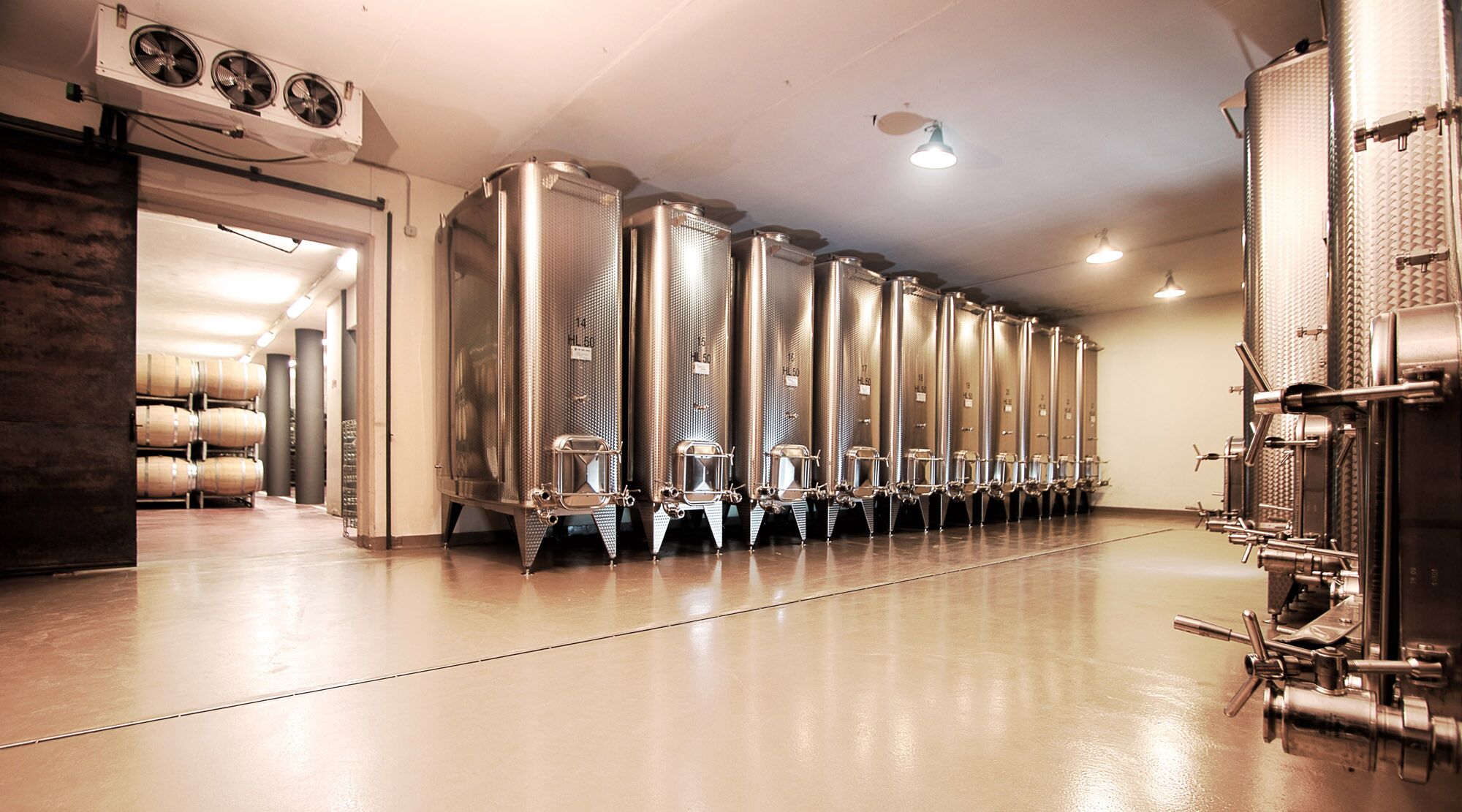 While
on a whirlwind marketing trip, Alessandro sat down
with me for dinner in New York, where he said, “We
want to make approachable wines that you don’t
have to wait years to develop, wines that you can
drink when we release them. For the Nebbiolo
Langhe we work with 50% younger grapes from our
vineyards that are four to 20 years old and 50%
from older vineyards that we rent in the Roero
region. We aim to make Barolos with softer
tannins. Our aim is to be more like the Grand Crus
of Burgundy, not Bordeaux. We believe that the
Nebbiolo grape [used in Barolo] can achieve the
finesse of Burgundy’s Pinot Noir but have its own
distinct personality. We want to show that our
crus are each one distinctive from the other.”
While
on a whirlwind marketing trip, Alessandro sat down
with me for dinner in New York, where he said, “We
want to make approachable wines that you don’t
have to wait years to develop, wines that you can
drink when we release them. For the Nebbiolo
Langhe we work with 50% younger grapes from our
vineyards that are four to 20 years old and 50%
from older vineyards that we rent in the Roero
region. We aim to make Barolos with softer
tannins. Our aim is to be more like the Grand Crus
of Burgundy, not Bordeaux. We believe that the
Nebbiolo grape [used in Barolo] can achieve the
finesse of Burgundy’s Pinot Noir but have its own
distinct personality. We want to show that our
crus are each one distinctive from the other.”
Without generations of Veglios
stuck in the old ways of making Barolo, Alessandro
is free to experiment. “My uncle Mauro had no
children,” he said, “so he told me, ‘What if we go
crazy? Let’s try whatever you think will work.’”
Part of what Alessandro feels must work
is attention to global warming in the vineyards.
“We want to keep the grapes from getting burned by
the sun,” he said, “So we leave more leaves to
cover the grapes. We also installed netting on
both sides of the vineyards’ roads in order to
guard against hail, but we’ve found they are also
providing additional shade.”
 The Veglios use no
herbicides or pesticides, instead using pheromones
that “confuse the mating habits of insects and
limit their reproduction.” Grapes
are exposed to natural wild yeasts, not
inoculations. Except for the Paiagalo cru,
all aging is done in small French oak barriques.
The Veglios use no
herbicides or pesticides, instead using pheromones
that “confuse the mating habits of insects and
limit their reproduction.” Grapes
are exposed to natural wild yeasts, not
inoculations. Except for the Paiagalo cru,
all aging is done in small French oak barriques.
 Strong evidence of the
Veglios’ plans to make their wines more drinkable
upon release is to be found in their very good
Langhe Nebbiolo 2018 ($25), which is not aged in
new oak, has a medium body, well-knit fruit, acid
and light tannins and an adaptability to a wide
range of foods. It’s wholly ready to consume right
now, and, given its price, on a regular basis.
Strong evidence of the
Veglios’ plans to make their wines more drinkable
upon release is to be found in their very good
Langhe Nebbiolo 2018 ($25), which is not aged in
new oak, has a medium body, well-knit fruit, acid
and light tannins and an adaptability to a wide
range of foods. It’s wholly ready to consume right
now, and, given its price, on a regular basis.
The Barolo Classico 2016 ($39)
is from what Alessandro says is “the most
beautiful vintage I’ve ever seen, right from the
start of the growing season through harvest.” The
wine is exemplary of what happens when nature
cooperates so completely, giving up a voluptuous
body and layered texture of dark fruits balanced
with acid and tannins that provide character.
Barolo Gattera 20 ($60) is more
complex, drier than the Classico but still very
full of the fruit flavor of first-rate Nebbiolo.
Of
the crus, Arborina 2016 ($60) comes from “soil poor in
nutrients, consisting of Sant’Agata Marl, a mix of
clay, fine sand, and limestone,” which make the
vines struggle but also to produce wines with a
great deal of fruitiness and concentration.Flavors
get bigger and more intense with Casteletto 2016 ($60),
from four hectares in a southeast position with a
high content of sandstone. Paiagallo 2016 ($90)
originates on the eastern slopes of the township
of Barolo, and at 15% I found it too heavy, too
dense and not in line with Mauro Veglio's intent
to produce wines to be enjoyed upon release.
❖❖❖
 FOOD WRITING 101: DANIELLE STEEL
SHOULD
FOOD WRITING 101: DANIELLE STEEL
SHOULD
NOT BE A MODEL FOR FOOD RAPTURE
“It’s been a year
since I said goodbye
to
you. Your cheesy
delights, your garlic-dusted edges. I gave you up
for a full 365 days, and to be frank, it was a
terrible year. I don’t mean that in the hyperbolic
way that lovers do when they’re finally reunited. I
mean that it was a Bad Year™, and after all this
time, I guess I’m just one pizza-hungry Andrew
Lincoln, standing outside your door with several
sheets of poster board that reveal my Dominos order.
But like Andrew, I know now that I can walk
away.”—Justin Kirkland, "What I Learned About
Love During My Year Without Pizza," Esquire.com
(1/1/20)
LET US KNOW HOW YOU
MAKE OUT
"If
there’s one thing we’ve learned in the last several
months, it’s that a good fried chicken sandwich is
worth fighting for."—Carly McFadden, Cleveland
Magazine (2/6/20).
Any of John Mariani's books below may be ordered from amazon.com.
 The Hound in Heaven
(21st Century Lion Books) is a novella, and
for anyone who loves dogs, Christmas, romance,
inspiration, even the supernatural, I hope you'll find
this to be a treasured favorite. The story
concerns how, after a New England teacher, his wife and
their two daughters adopt a stray puppy found in their
barn in northern Maine, their lives seem full of promise.
But when tragedy strikes, their wonderful dog Lazarus and
the spirit of Christmas are the only things that may bring
his master back from the edge of despair.
The Hound in Heaven
(21st Century Lion Books) is a novella, and
for anyone who loves dogs, Christmas, romance,
inspiration, even the supernatural, I hope you'll find
this to be a treasured favorite. The story
concerns how, after a New England teacher, his wife and
their two daughters adopt a stray puppy found in their
barn in northern Maine, their lives seem full of promise.
But when tragedy strikes, their wonderful dog Lazarus and
the spirit of Christmas are the only things that may bring
his master back from the edge of despair. WATCH THE VIDEO!
“What a huge surprise turn this story took! I was completely stunned! I truly enjoyed this book and its message.” – Actress Ali MacGraw
“He had me at Page One. The amount of heart, human insight, soul searching, and deft literary strength that John Mariani pours into this airtight novella is vertigo-inducing. Perhaps ‘wow’ would be the best comment.” – James Dalessandro, author of Bohemian Heart and 1906.
“John Mariani’s Hound in Heaven starts with a well-painted portrayal of an American family, along with the requisite dog. A surprise event flips the action of the novel and captures us for a voyage leading to a hopeful and heart-warming message. A page turning, one sitting read, it’s the perfect antidote for the winter and promotion of holiday celebration.” – Ann Pearlman, author of The Christmas Cookie Club and A Gift for my Sister.
“John Mariani’s concise, achingly beautiful novella pulls a literary rabbit out of a hat – a mash-up of the cosmic and the intimate, the tragic and the heart-warming – a Christmas tale for all ages, and all faiths. Read it to your children, read it to yourself… but read it. Early and often. Highly recommended.” – Jay Bonansinga, New York Times bestselling author of Pinkerton’s War, The Sinking of The Eastland, and The Walking Dead: The Road To Woodbury.
“Amazing things happen when you open your heart to an animal. The Hound in Heaven delivers a powerful story of healing that is forged in the spiritual relationship between a man and his best friend. The book brings a message of hope that can enrich our images of family, love, and loss.” – Dr. Barbara Royal, author of The Royal Treatment.
 |
The Encyclopedia of American Food and Drink by John F. Mariani (Bloomsbury USA, $35) Modesty forbids me to praise my own new book, but let me proudly say that it is an extensive revision of the 4th edition that appeared more than a decade ago, before locavores, molecular cuisine, modernist cuisine, the Food Network and so much more, now included. Word origins have been completely updated, as have per capita consumption and production stats. Most important, for the first time since publication in the 1980s, the book includes more than 100 biographies of Americans who have changed the way we cook, eat and drink -- from Fannie Farmer and Julia Child to Robert Mondavi and Thomas Keller. "This book is amazing! It has entries for everything from `abalone' to `zwieback,' plus more than 500 recipes for classic American dishes and drinks."--Devra First, The Boston Globe. "Much needed in any kitchen library."--Bon Appetit. |
"Eating Italian will never be the same after reading John Mariani's entertaining and savory gastronomical history of the cuisine of Italy and how it won over appetites worldwide. . . . This book is such a tasteful narrative that it will literally make you hungry for Italian food and arouse your appetite for gastronomical history."--Don Oldenburg, USA Today. "Italian
restaurants--some good, some glitzy--far
outnumber their French rivals. Many of
these establishments are zestfully described
in How Italian Food Conquered the World, an
entertaining and fact-filled chronicle by
food-and-wine correspondent John F.
Mariani."--Aram Bakshian Jr., Wall Street
Journal.
"Equal parts
history, sociology, gastronomy, and just
plain fun, How Italian Food Conquered the
World tells the captivating and delicious
story of the (let's face it) everybody's
favorite cuisine with clarity, verve and
more than one surprise."--Colman Andrews,
editorial director of The Daily
Meal.com. "A fantastic and fascinating
read, covering everything from the influence
of Venice's spice trade to the impact of
Italian immigrants in America and the
evolution of alta cucina. This book will
serve as a terrific resource to anyone
interested in the real story of Italian
food."--Mary Ann Esposito, host of PBS-TV's
Ciao
Italia. "John Mariani has written the
definitive history of how Italians won their
way into our hearts, minds, and
stomachs. It's a story of pleasure over
pomp and taste over technique."--Danny Meyer,
owner of NYC restaurants Union Square
Cafe, The Modern, and Maialino.
|
 |
 |
 |
 |
 |
 |
 |
 |
 Everett Potter's Travel Report:
Everett Potter's Travel Report: 
 Eating Las Vegas
JOHN CURTAS has been covering the Las Vegas
food and restaurant scene since 1995. He is
the co-author of EATING LAS VEGAS – The 50
Essential Restaurants (as well as
the author of the Eating Las Vegas web site: www.eatinglasvegas.
He can also be seen every Friday morning as
the “resident foodie” for Wake Up With the
Wagners on KSNV TV (NBC) Channel 3 in
Las Vegas.
Eating Las Vegas
JOHN CURTAS has been covering the Las Vegas
food and restaurant scene since 1995. He is
the co-author of EATING LAS VEGAS – The 50
Essential Restaurants (as well as
the author of the Eating Las Vegas web site: www.eatinglasvegas.
He can also be seen every Friday morning as
the “resident foodie” for Wake Up With the
Wagners on KSNV TV (NBC) Channel 3 in
Las Vegas.
MARIANI'S VIRTUAL GOURMET
NEWSLETTER is published weekly. Publisher: John Mariani. Editor: Walter Bagley. Contributing Writers: Christopher Mariani,
Robert Mariani, Misha Mariani, John A. Curtas, Gerry Dawes, Geoff Kalish,
and Brian Freedman. Contributing
Photographer: Galina Dargery. Technical
Advisor: Gerry
McLoughlin.
If you wish to subscribe to this
newsletter, please click here: http://www.johnmariani.com/subscribe/index.html
© copyright John Mariani 2020

